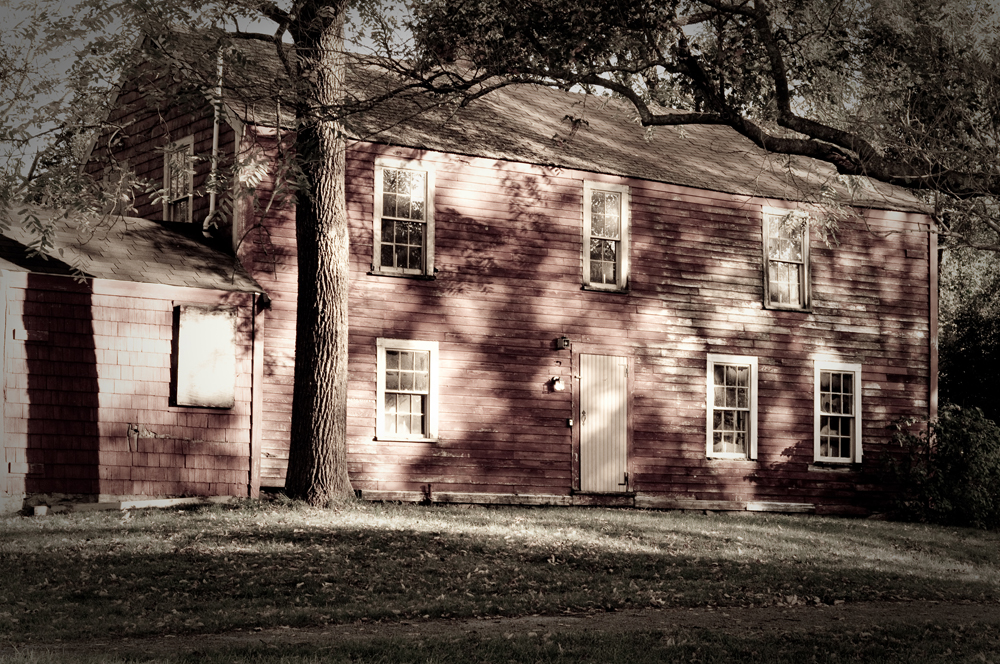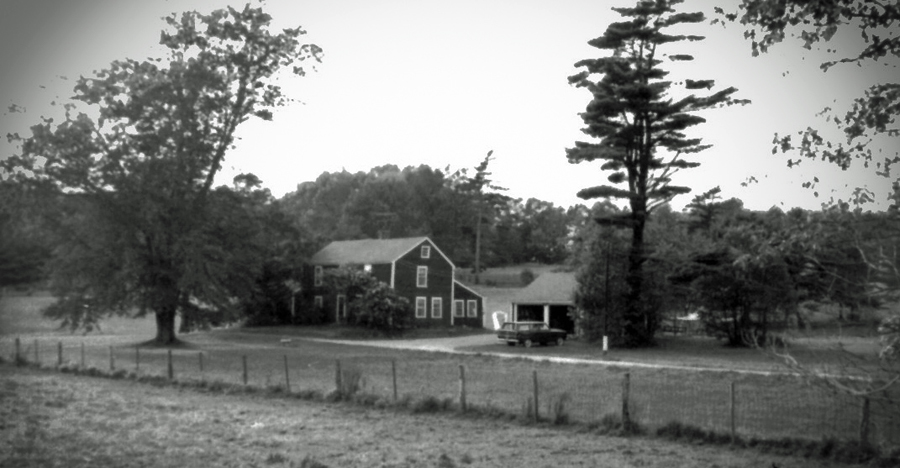Canton’s True Tales: The 300-year-old house
By George T. ComeauThis story originally appeared in the Canton Citizen in October 2011.
As the leaves fall and autumn returns to New England, there is one house that stands apart as a silent reminder to the pilgrims from England. Three hundred seasons have come and gone, leaves fallen on the roof, snow at the lintels, wind against the gables, and frost creeping against the fieldstone foundation. There are very few places in Canton where you immediately are transported to another time and place and walk in the footsteps of our first settlers. The Little Red House at Pequitside Farm is just such a place.
The view from the front door is largely unchanged. You stand on a large stone, half round, perhaps found in a nearby field and put to use in 1725. With your back to the house, the view is magnificent, across a rolling meadow with whitetail deer jumping in unison through a broad expanse. This is David Tilden’s front door.
Born in Scituate, Tilden was one of 12 children born to Stephen Tilden and Hannah Little. His grandfather Nathanial came from the Tenterden area of Kent, England. After an initial visit to America, Nathanial returned to England, gathered his family and arrived in 1627 to Scituate. The Tilden family left England after swearing an oath of allegiance and supremacy and emigrated on the ship Hercules, which was partially owned by Tilden and mastered by John Witherley. History records the ship’s destination as bound for the plantation called “England in America.”
The members of the Tilden family were fairly well off, and they traveled with servants and sufficient supplies to make a new home. As part owners of the ship, and having scouted their new home, they were unlike many of the pilgrims that had arrived in 1620. Things had changed in seven years, and the land available to new settlers was vast and relatively affordable. The Tildens purchased that portion of Scituate called “Two Mile” tract, now known as North Marshfield. Nathaniel’s farm extended both sides of the North River, part of it being on “Gravelly Beach.”
The point to the history lesson on the Tilden family is that they were pioneers in the truest sense. Setting off into the relatively unknown was not something that they easily shied away from. And keeping with the family tradition, David Tilden set off to pioneer the wilds of Dorchester with his wife, Abigail Pitcher, of Milton.
By the time David and Abigail had arrived in Dorchester Village, now present day Canton Corner, they found a small village at the intersection of Pleasant and Washington streets. In 1654, this area had been established as the Ponkapoag Plantation, 6,000 acres of land set aside for the Ponkapoag Indians. And it was from the native people that Tilden received his deed of land. The deed signed by Amos Ahauton, Thomas Ahauton, Simon George, Hezekiah Squamaog and George Hunter gave land ownership of 20 acres to David Tilden, Husbandman, “outdone of the English Tenants of Lessees…” for 5 pounds 15 shillings, “a certain messuage or Tenement with lands thereto belonging.”
Work on the homestead began immediately. A small building was already on the site where Tilden planned to build his new home. Jabez Searle, who had received a grant from his father, Robert, in 1710, had lived on the property until at least 1723. Apparently Searle lived in a small building, most likely the rear portion of the present-day Tilden House.
David and Abigail had been busy during their first 15 years of marriage and produced six children. It was apparent that by the size of the family that a large house was called for. The original portion of the house built by Tilden consists of the two east rooms in the two-story front portion of the house, along with the lean-to built by Searle around 1710.
Inside this house the visitor ducks down a bit as the ceilings are quite low. Exposed chamfered beams still run through several rooms, and original woodwork remains extant from room to room. The great cooking fireplace and beehive oven are tucked in the original single room, the fires long since extinguished.
The house itself is remarkable for more than its age. Owned by the town of Canton, this house locally became known as the “Little Red House” after preservationists attempted to save the building from neglect in the late 1970s. In the summer of 1973, a demolition order had been given by the building commissioner to raze the structure. On July 15, a local group of concerned citizens gathered at the Canton Historical Society to begin the process of saving the Tilden House. This early effort was most impressive and was led by state Representative Paul Schneiders, William Reynolds, the chairman of the Board of the Neponset Valley Bank, Richard Sarra, Robert Jordan, Joseph Leary Jr., and Historical Society President Katherine Sullivan.
These first efforts allowed for the successful stabilization and removed the immediate threat. Without a use for the building, however, it once again began to slip back into time. In 2003, a new nonprofit friends group was created and continues the wok begun in 1973. Fundraising has been ongoing, and leaders like our state Representative Bill Galvin have been extremely supportive. But again, we are at a turning point for the Tilden House. Action is now needed to begin the preservation process in earnest.
The threat of neglect exists, and Canton’s best colonial site again is moving toward decay. So why care? The Tilden House was built in the first period of settlement of America and is called a “first period house.” What is remarkable is that less than 300 true first period houses exist today. Towns that value these buildings include places like Salem, Dedham, Plymouth, Gloucester and Ipswich.
The next step in the life of this remarkable historic site may very well rest in your hands. On October 14, the Friends of the Little Red House will gather at the Canton Historical Society at 7 p.m. Will you find some time in your life to help preserve a legacy extending for more than 300 years?
There are no ghosts at the Little Red House, just the fingers of time creeping through the bedchambers. The afternoon light casts long shadows across the wood floors, and every day this house waits for the sounds of voices to come and save it from destruction. Will you lend your work, wealth, or wisdom to our renewed efforts? Time will tell.
If you would like to help the preservation efforts, contact George Comeau at 617-713-4747. New friends are always welcomed.
Short URL: https://www.thecantoncitizen.com/?p=8575












